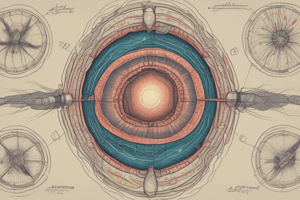Podcast
Questions and Answers
What is the infective stage of Taenia saginata and Taenia solium?
What is the infective stage of Taenia saginata and Taenia solium?
- Cysticercus (correct)
- Mature proglottid
- Larvae
- Egg
What is the characteristic of the scolex region of the Tapeworm?
What is the characteristic of the scolex region of the Tapeworm?
- Immature proglottids
- Suckers, hooklets, and grooves (correct)
- Germinal portion
- Mature proglottids
What is the mechanism by which animals become infected with Taenia saginata or Taenia solium?
What is the mechanism by which animals become infected with Taenia saginata or Taenia solium?
- By touching infected feces
- Through direct contact with an infected animal
- Through a vector such as a mosquito
- By ingesting contaminated vegetation with eggs or gravid proglottids (correct)
What is the number of uterine branches in the gravid proglottid of Taenia solium?
What is the number of uterine branches in the gravid proglottid of Taenia solium?
What is the stage of development that survives for several years in the animal's muscles?
What is the stage of development that survives for several years in the animal's muscles?
What is the disease caused by Taenia solium in humans?
What is the disease caused by Taenia solium in humans?
What is the intermediate host for Taenia saginata?
What is the intermediate host for Taenia saginata?
What is the structure used by the adult tapeworm to attach to the small intestine?
What is the structure used by the adult tapeworm to attach to the small intestine?
Which host is definitive for Ecchinococcus granulosus?
Which host is definitive for Ecchinococcus granulosus?
How do humans become infected with Taenia saginata or Taenia solium?
How do humans become infected with Taenia saginata or Taenia solium?
What is the size of Taenia saginata?
What is the size of Taenia saginata?
Study Notes
Taenia saginata and Taenia solium
- Infective stage for both species is the cysticerci, which are larval forms found in the tissues of intermediate hosts.
- Intermediate host for Taenia saginata is cattle, while Taenia solium primarily infects pigs.
- Humans become infected through ingestion of undercooked or raw meat containing these cysticerci.
Scolex Region Characteristics
- The scolex is the head region of the tapeworm, equipped with structures for attachment to the host's intestine.
- Taenia saginata scolex features four prominent suckers, while Taenia solium has a scolex with hooks surrounding its suckers.
Mechanism of Infection
- Infection occurs when animals ingest eggs or proglottids from contaminated food or water, leading to the development of cysticerci within their muscles.
- In humans, infection arises from consuming undercooked meats containing larval cysts.
Gravid Proglottid Structure
- The gravid proglottid of Taenia solium possesses 7-13 uterine branches, which differentiate it from Taenia saginata that has 15-30.
Developmental Stage
- Cysticercus is the stage that can survive for years in the muscles of animals, remaining viable until consumed by the definitive host.
Disease in Humans
- Taenia solium can cause cysticercosis in humans, a serious condition resulting from larval cysts invading tissues, leading to neurological issues if in the brain.
Definitive Host for Echinococcus granulosus
- Dogs serve as the definitive hosts for Echinococcus granulosus, shedding eggs in their feces, which can infect intermediate hosts like sheep.
Adult Tapeworm Attachment
- The structure used for attachment to the small intestine is the scolex, which allows the adult tapeworm to anchor securely in the host's digestive tract.
Size of Taenia saginata
- Taenia saginata can grow significantly large, often reaching lengths of up to 10 meters or more, making it one of the longest human tapeworms.
Studying That Suits You
Use AI to generate personalized quizzes and flashcards to suit your learning preferences.
Description
Test your knowledge on Cestoda, a class of tapeworms, specifically on the morphology and characteristics of Taenia saginata and Taenia solium. This quiz covers the structure, body regions, and features of these parasitic worms. How well do you understand their biology?




